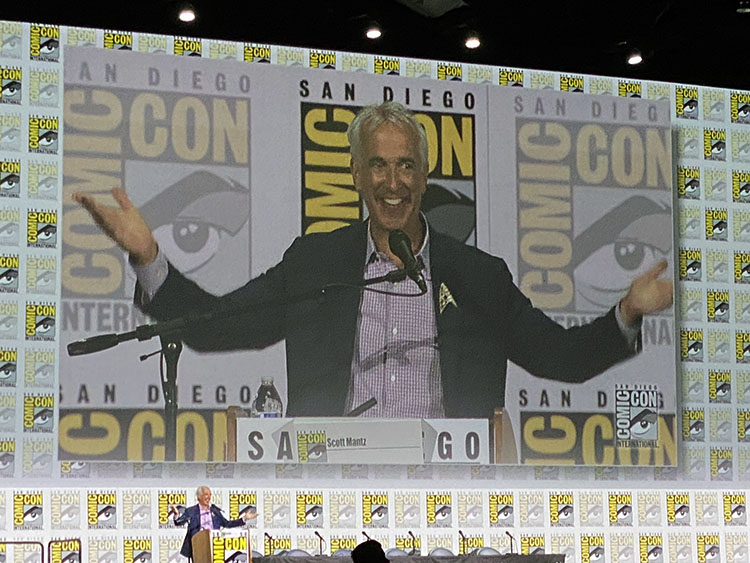
By Shor M. Masori
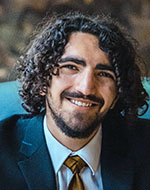
SAN DIEGO – With writers and actors on strike and prohibited by SAG/AFTRA and WGA from promoting upcoming productions, this year’s Comic-Con was without many people who normally would have participated on panels. What was left at times seemed slapdash and makeshift, leaving most attendees wanting more, a harbinger of the content-cold year that the strikes will mean for fans around the world.
Scheduled before the strikes, but subsequently canceled, were a variety of stars including several from the Jewish community. William Shatner did not appear at a panel devoted to William Shatner: You Can Call Me Bill, a documentary about his recent short ride into space.
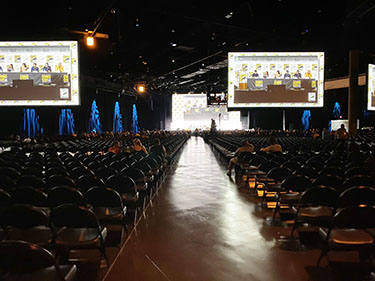
Scheduled to be shown in Hall H, which holds over 5,500 people, the Shatner-less panel drew an estimated 700 fans, according to a Comic-Con worker on scene – the least amount of people she had ever seen attending a panel in Comic-Con’s largest hall.
Personally, I found this to be one of the most interesting panels, as they had representatives from Blue Origin and Space for Humanity talking about their mission to popularize commercial space travel. While this premise alone would have brought most nerds out of our caves, this was a Bill Shatner panel without Bill Shatner. Once attendees heard that news, many left the Hall.
The Star Trek Universe panel, which had been ballyhooed as a coming attraction during last year’s Comic-Con, was essentially without a panel. Scott Mantz, a film critic and event moderator, appeared alone to introduce the first-ever crossover episode between two Star Trek shows, the live-action Star Trek: Strange New Worlds and the animated Star Trek: Lower Decks.
The presentation, meant to bring the two casts on stage together, was hastily reorganized and shortened from the original 2-hour time slot to 75 minutes. This was one of many panels that rather than being canceled simply was shortened to include the newest episode coming out.
Mantz, a member of the Jewish community, estimated that 6,500 people filled the audience to watch the show. “Though I had to fly solo hosting a presentation with no panelists, I did the best I could as a seasoned and professional host (not to mention as a lifelong Star Trek fan), and it was quite obvious to me from the energy in the room, the laughter and the applause that everyone had a great time with the sneak peeks, the breaking news and the full Star Trek episode that was shown. That’s what we call making lemonade out of lemons,” he said later.
A few days before the July 20-23 Comic-Con, DC Universe and other production houses withdrew from the convention, denying fans a chance to see David Corenswet, the first Jewish actor to play the part of Superman, the superhero who was created by two Jewish collaborators, Joe Shuster and Jerry Siegel.
Missing from a MAX original animation panel were the writers and actors for Harley Quinn; Adventure Time: Fiona and Cake; and Young Love, with only the showrunners and supervising directors from each on the panel. The character of Harley Quinn is a secular, Jewish Brooklynite living in Gotham. Formerly a sidekick to the villain Joker, in the upcoming season she has switched allegiances to join the Batman family.
Good Omens, a show in which the archangel Gabriel – who is mentioned in the Tanakh (Daniel 8:15-26 and 9:21-27) – has come with amnesia to Earth at the start of its new season. Although John Hamm plays the character, he too was missing from a panel “discussion,” which didn’t even have a live moderator. The “panel” consisted simply of a pre-recorded ten-minute discussion of the new season followed by a showing of the first episode. A short Q&A session that was recorded July 10 answered questions that had been submitted via Instagram. Attendees at Comic-Con saw a table without anyone there.
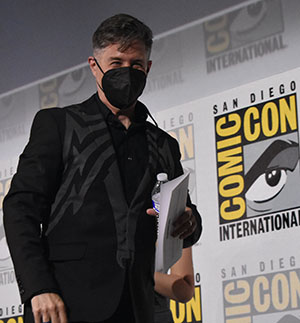
Unaffected by the strikes was one for Spiderman Two: Symbiotic Relationships, a video game produced by PlayStation 5. Video game and voice actors are members of different unions which are not on strike, though are generally supportive of strikers. Among the panelists was Yuri Lowenthal, the voice of Spiderman and his alter-ego Peter Parker. He wore a suit resembling Venom’s black costume. Lowenthal refers to himself as a “Tennessee Jew” and was the voice of Ben Tennyson, the lead of Ben 10, a cartoon franchise about a boy who can transform into alien species.
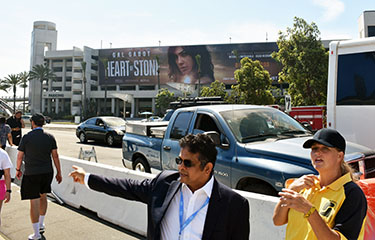
Also there, at least in a sense, was Gal Gadot, who starred in Wonder Woman and now has the lead role in Heart of Stone about an intelligence operative for a global peace keeping organization. Her giant image was draped over the parking lot of a Hilton Hotel adjacent to the San Diego Convention Center, where Comic-Con is held.
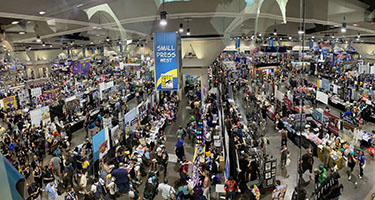
The paucity of big names led to more people than usual cramming Comic-Con’s exhibit hall in preference to the bigger conference rooms. Funko, a toy brand specializing in pop culture characters, rented a large section to simulate a neighborhood with stores selling Funko merchandise. Lego created an entire “Brickbusters,” a spoof on “Blockbusters,” with fake movie posters, Lego sculptures, and merchandise as well. Two well-attended attractions were Volante and Hero Within outlets selling officially licensed Star-Trek jackets, patches, and pins.
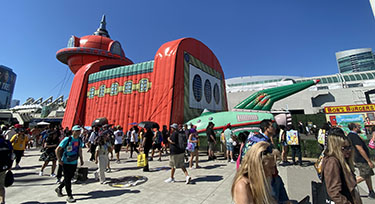
Hero Within also rented a venue in San Diego’s nearby Gaslamp Quarter, transforming it into the “Energizer Lounge” with Star Trek themed coffee drinks. Also near the Convention Center was an animated 2-D “Animayhem” exhibit at which fans could interact with adult animated TV shows such as Futurama and Bob’s Burgers. There were three-hour waits on line to buy burgers from the Bob’s Burgers outlet and to take photographs next to the laboratory and ship from Futurama.
Amid discussions of “Who’s Here?” and “Who’s Not?” panelists adroitly avoided discussing projects covered by SAG/AFTRA and WGA contracts. For example, on one panel, instead of citing the name of Breaking Bad, panelists used the circumlocution of “that show where a chemistry teacher cooked meth.”
Panelists on “Science and Schmience of Arrowverse” – dealing with the real and pseudo-science of multiple television series – declined to talk about shows on which they had worked. Jonathan Butler, a writer and executive producer for The Flash, only referred to the show as the “Red Blurry Man Show.” Elsewhere, instead of referring to Superman and Lois, a panelist simply alluded to a “super-guy show.”
Panels focusing on the roles of minorities in show business voiced similar themes about their lack of representation in the work force. They expressed frustration over unnuanced stereotyping and broad-brush characterizations. A Jewish-themed panel and one of the Middle Eastern and North African (MENA) community voiced similar complaints.
This year’s Comic-Con’s lackluster and hurried panel arrangements are harbingers of this coming Fall and Winter seasons when the effects of the two strikes will be felt by most TV and movie fans.
*
Shor M. Masori is a staff writer and photographer for San Diego Jewish World. He may be contacted via shor.masori@sdjewishworld.com